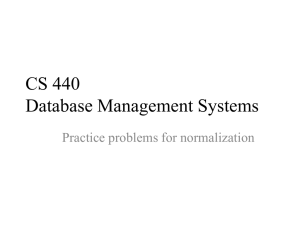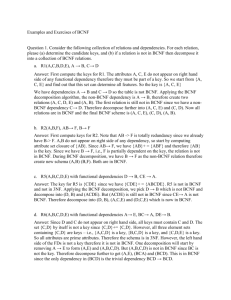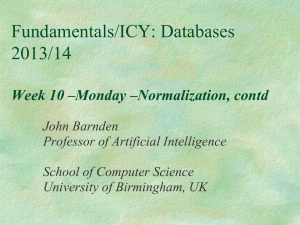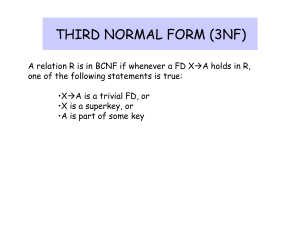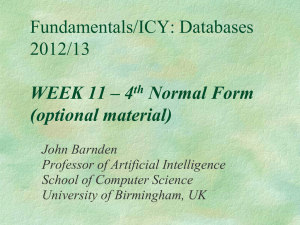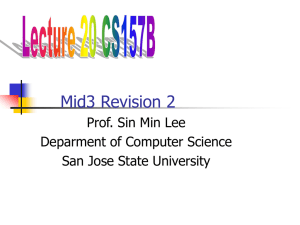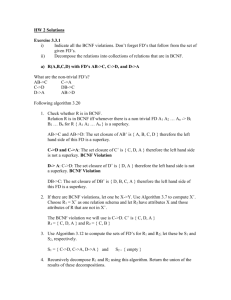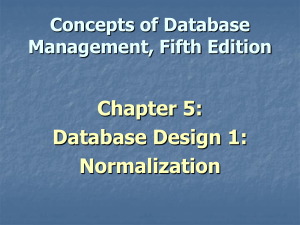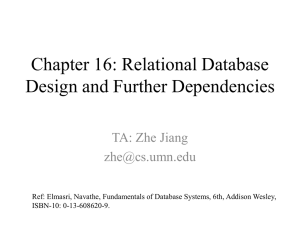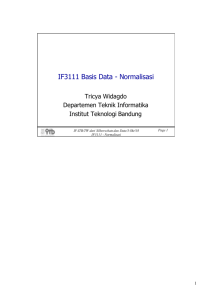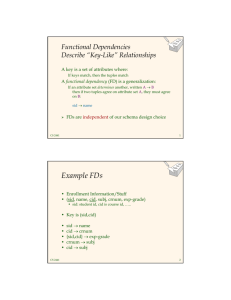normal_forms
advertisement
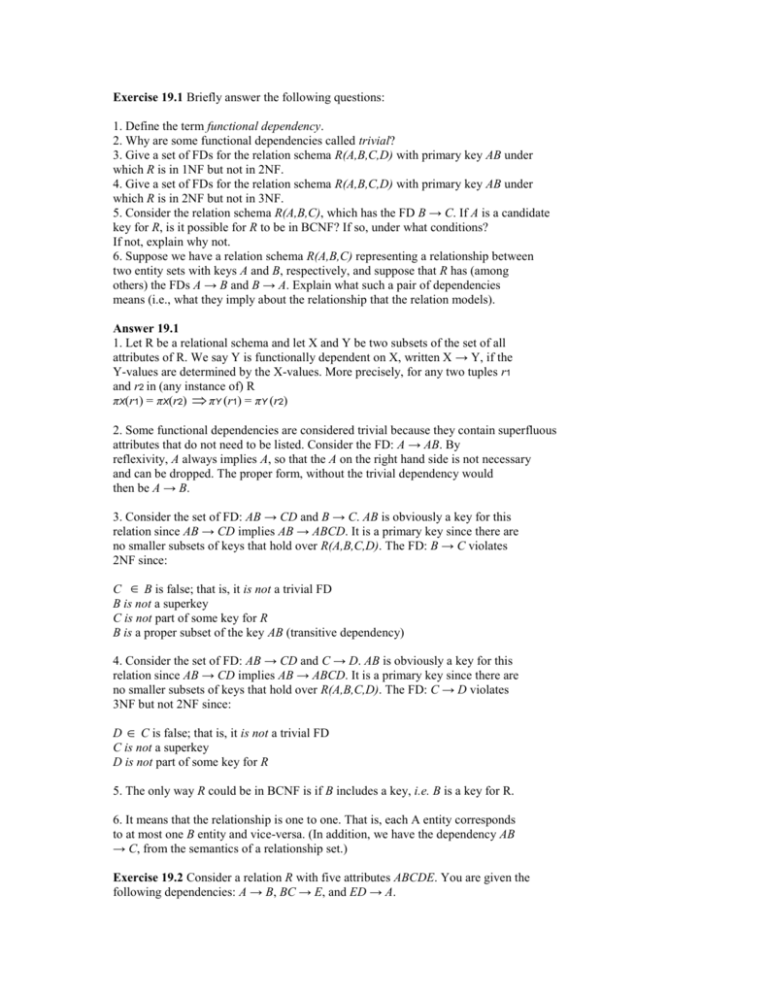
Exercise 19.1 Briefly answer the following questions: 1. Define the term functional dependency. 2. Why are some functional dependencies called trivial? 3. Give a set of FDs for the relation schema R(A,B,C,D) with primary key AB under which R is in 1NF but not in 2NF. 4. Give a set of FDs for the relation schema R(A,B,C,D) with primary key AB under which R is in 2NF but not in 3NF. 5. Consider the relation schema R(A,B,C), which has the FD B → C. If A is a candidate key for R, is it possible for R to be in BCNF? If so, under what conditions? If not, explain why not. 6. Suppose we have a relation schema R(A,B,C) representing a relationship between two entity sets with keys A and B, respectively, and suppose that R has (among others) the FDs A → B and B → A. Explain what such a pair of dependencies means (i.e., what they imply about the relationship that the relation models). Answer 19.1 1. Let R be a relational schema and let X and Y be two subsets of the set of all attributes of R. We say Y is functionally dependent on X, written X → Y, if the Y-values are determined by the X-values. More precisely, for any two tuples r1 and r2 in (any instance of) R πX(r1) = πX(r2) πY (r1) = πY (r2) 2. Some functional dependencies are considered trivial because they contain superfluous attributes that do not need to be listed. Consider the FD: A → AB. By reflexivity, A always implies A, so that the A on the right hand side is not necessary and can be dropped. The proper form, without the trivial dependency would then be A → B. 3. Consider the set of FD: AB → CD and B → C. AB is obviously a key for this relation since AB → CD implies AB → ABCD. It is a primary key since there are no smaller subsets of keys that hold over R(A,B,C,D). The FD: B → C violates 2NF since: C B is false; that is, it is not a trivial FD B is not a superkey C is not part of some key for R B is a proper subset of the key AB (transitive dependency) 4. Consider the set of FD: AB → CD and C → D. AB is obviously a key for this relation since AB → CD implies AB → ABCD. It is a primary key since there are no smaller subsets of keys that hold over R(A,B,C,D). The FD: C → D violates 3NF but not 2NF since: D C is false; that is, it is not a trivial FD C is not a superkey D is not part of some key for R 5. The only way R could be in BCNF is if B includes a key, i.e. B is a key for R. 6. It means that the relationship is one to one. That is, each A entity corresponds to at most one B entity and vice-versa. (In addition, we have the dependency AB → C, from the semantics of a relationship set.) Exercise 19.2 Consider a relation R with five attributes ABCDE. You are given the following dependencies: A → B, BC → E, and ED → A. 1. List all keys for R. 2. Is R in 3NF? 3. Is R in BCNF? Answer 19.2 Answer omitted. Exercise 19.3 Consider the relation shown in Figure 19.1. 1. List all the functional dependencies that this relation instance satisfies. 2. Assume that the value of attribute Z of the last record in the relation is changed from z3 to z2. Now list all the functional dependencies that this relation instance satisfies. XYZ x1 y1 z1 x1 y1 z2 x2 y1 z1 x2 y1 z3 Figure 19.1 Relation for Exercise 19.3. Answer 19.3 1. The following functional dependencies hold over R: Z → Y, X → Y, and XZ → Y 2. Same as part 1. Functional dependency set is unchanged. Exercise 19.4 Assume that you are given a relation with attributes ABCD. 1. Assume that no record has NULL values. Write an SQL query that checks whether the functional dependency A → B holds. 2. Assume again that no record has NULL values. Write an SQL assertion that enforces the functional dependency A → B. 3. Let us now assume that records could have NULL values. Repeat the previous two questions under this assumption. Answer 19.4 Answer omitted. Exercise 19.5 Consider the following collection of relations and dependencies. Assume that each relation is obtained through decomposition from a relation with attributes ABCDEFGHI and that all the known dependencies over relation ABCDEFGHI are listed for each question. (The questions are independent of each other, obviously, since the given dependencies over ABCDEFGHI are different.) For each (sub)relation: (a) State the strongest normal form that the relation is in. (b) If it is not in BCNF, decompose it into a collection of BCNF relations. 1. R1(A,C,B,D,E), A → B, C → D 2. R2(A,B,F), AC → E, B → F 3. R3(A,D), D → G, G → H 4. R4(D,C,H,G), A → I, I → A 5. R5(A,I,C,E) Answer 19.5 1. 1NF. BCNF decomposition: AB, CD, ACE. 2. 1NF. BCNF decomposition: AB, BF 3. BCNF. 4. BCNF. 5. BCNF. Exercise 19.7 Suppose you are given a relation R with four attributes ABCD. For each of the following sets of FDs, assuming those are the only dependencies that hold for R, do the following: (a) Identify the candidate key(s) for R. (b) Identify the best normal form that R satisfies (1NF, 2NF, 3NF, or BCNF). (c) If R is not in BCNF, decompose it into a set of BCNF relations that preserve the dependencies. 1. C → D, C → A, B → C 2. B → C, D → A 3. ABC → D, D → A 4. A → B, BC → D, A → C 5. AB → C, AB → D, C → A, D → B Answer 19.7 1. (a) Candidate keys: B (b) R is in 2NF but not 3NF. (c) C → D and C → A both cause violations of BCNF. One way to obtain a (lossless) join preserving decomposition is to decompose R into AC, BC, and CD. 2. (a) Candidate keys: BD (b) R is in 1NF but not 2NF. (c) Both B → C and D → A cause BCNF violations. The decomposition: AD, BC, BD (obtained by first decomposing to AD, BCD) is BCNF and lossless and join-preserving. 3. (a) Candidate keys: ABC, BCD (b) R is in 3NF but not BCNF. (c) ABCD is not in BCNF since D → A and D is not a key. However if we split up R as AD, BCD we cannot preserve the dependency ABC → D. So there is no BCNF decomposition. 4. (a) Candidate keys: A (b) R is in 2NF but not 3NF (because of the FD: BC → D). (c) BC → D violates BCNF since BC does not contain a key. So we split up R as in: BCD, ABC. 5. (a) Candidate keys: AB, BC, CD, AD (b) R is in 3NF but not BCNF (because of the FD: C → A). (c) C → A and D → B both cause violations. So decompose into: AC, BCD but this does not preserve AB → C and AB → D, and BCD is still not BCNF because D → B. So we need to decompose further into: AC, BD, CD. However, when we attempt to revive the lost functioanl dependencies by adding ABC and ABD, we that these relations are not in BCNF form. Therefore, there is no BCNF decomposition.

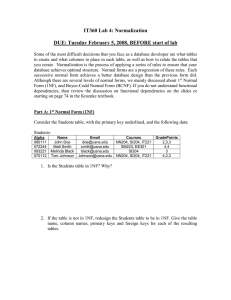
![11. Normalization.ppt [Compatibility Mode]](http://s3.studylib.net/store/data/008407772_1-68fccad9854cfc4ecbd558b11e3710cc-300x300.png)
